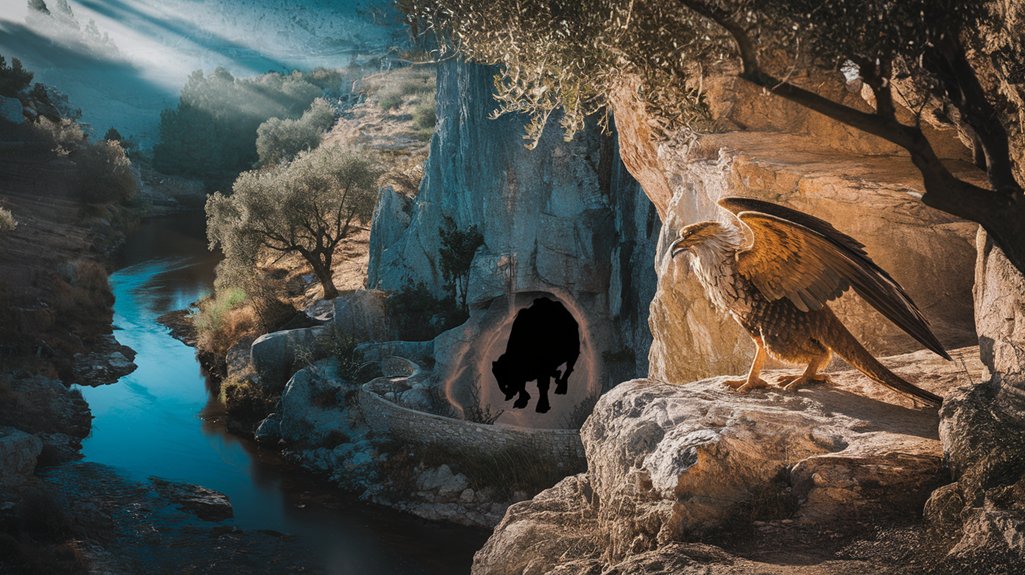You'll encounter the Alicanto in Chile's Atacama Desert, where this chimeric guardian sustains itself exclusively on gold, silver, and precious gemstones—its luminous plumage reflecting whichever metal it has consumed. Rooted in pre-Columbian Diaguita cosmology, this eldritch creature operates on a moral economy: it guides humble seekers toward mineral wealth while misdirecting the avaricious into phosphorescent oblivion. Your intentions determine whether those forge-fire eyes herald prosperity or desert death, a duality that has shaped Chile's extractive mythology since Chañarcillo's silver discovery in 1832. The traditions beneath this legend reveal deeper truths.
🔮 Enhance Your Practice With These Essentials
Chosen for ritual alignment and energetic correspondence.
🔮 Enhance Your Practice With These Essentials
Chosen for ritual alignment and energetic correspondence.
🎯 Recommended Products
Handpicked items related to this article:
As an Amazon Associate, we earn from qualifying purchases.
🔮 Enhance Your Practice With These Essentials
Chosen for ritual alignment and energetic correspondence.
🔮 Enhance Your Practice With These Essentials
Chosen for ritual alignment and energetic correspondence.
Key Takeaways
- The Alicanto is a luminous mythical bird from Chile's Atacama Desert that feeds exclusively on gold, silver, and precious gemstones.
- Its wings emit metallic radiance reflecting whichever precious metal it has consumed, with plumage shifting between copper-bronze and silver sheens.
- The creature guides humble miners to mineral wealth while leading greedy seekers astray, enforcing a moral economy of desert justice.
- Originating from pre-Columbian Diaguita and Atacameño cosmology, it became central to Chilean mining mythology after the 1832 Chañarcillo silver discovery.
- Modern Chile embraces the Alicanto as a cultural symbol, appearing in art, literature, and environmental movements against corporate mining exploitation.
The Legend of the Alicanto in Chilean Folklore

In the arid expanse of Chile's Atacama Desert—where moonlight transmutes copper veins into rivers of silver and the boundary between earth and sky dissolves into shimmering mirage—the Alicanto emerges from pre-Columbian oral traditions as a creature of profound duality.
You'll find its wings shine with metallic luminescence, sustenance derived entirely from precious ores hidden beneath volcanic stone. Gold-fed specimens radiate aureate brilliance; silver-eaters glow with lunar phosphorescence.
The Alicanto significance transcends mere treasure-guardian mythology. It represents mining communities' relationship with extractive fortune—leading worthy seekers toward wealth while condemning the avaricious to fatal disorientation.
This chimeric avian won't permit capture or direct observation.
Folklore variations span Chile's northern territories, each settlement preserving distinct interpretations. Antofagasta's miners describe eldritch cries echoing through canyon systems; Copiapó's storytellers emphasize its role as cosmic arbiter of human intention.
Indigenous Atacameño cosmology predating Spanish colonization positioned similar entities as intermediaries between terrestrial and mineral domains, suggesting continuous mythological evolution across centuries.
Physical Description and Mythical Characteristics
You'd find yourself transfixed by the alicanto's most distinctive feature: its luminous wings, which emit an otherworldly radiance born from the precious metals it devours—gold casting amber incandescence, silver producing pale moonlit gleams that pierce the Atacama's eldritch darkness.
The creature's chimeric form varies dramatically in chromatic intensity and corporeal dimensions, ranging from hawk-sized specimens to beings rivaling condors, their plumage shifting between metallic sheens of copper-bronze and argentate brilliance depending upon their mineral sustenance.
This phosphorescent manifestation, documented in Chilean folklore since the colonial period of the 1600s, renders the bird simultaneously visible yet ethereal, a paradox that has shaped prospector testimonies across centuries.
Luminous Wings and Appearance
The Alicanto manifests in the Atacama's moonless nights as a creature of impossible radiance, its plumage gleaming with metallic luminescence that shifts between copper-red and silver-white depending upon its most recent feast.
You'll find no natural explanation for these luminous feathers, which blind those who pursue the bird with greed-darkened hearts. The creature's wingspan stretches beyond mortal proportion, each dazzling flight leaving phosphorescent traces across desert skies.
Indigenous miners recognized this eldritch brilliance as both beacon and warning—the Alicanto's chimeric nature embodied the duality of mineral wealth itself. Its eyes burn like forge-fire.
The bird transcends mere avian classification, existing instead as pure manifestation of the earth's hidden treasures, a liminal guardian whose appearance signals proximity to veins of precious metal lying beneath Atacama's ancient, mineral-rich substrata.
Size and Color Variations
Beyond its ethereal glow, the Alicanto's physical dimensions shift according to the mineral wealth it consumes, altering the creature into a living barometer of subterranean riches.
When feeding upon gold deposits, you'll witness size variations changing it into an eagle-sized chimeric entity, wings spanning nearly two meters across the Atacama's ancient plateaus. Silver sustenance renders it smaller, more compact.
The color variations prove equally fluid—gold-fed Alicantos shimmer in aureate luminescence, their plumage reflecting the precious metal's characteristic warmth, while silver-gorged specimens emanate cooler, moonlit radiance.
This eldritch morphology serves as nature's prospecting tool, its body composition mirroring the desert's hidden treasures. Indigenous Diaguita miners, documenting these changes since pre-Columbian epochs, recognized the bird's chameleonic nature as direct correspondence with underground veins.
The Alicanto's Diet of Precious Metals and Gems

According to Chilean folklore passed down through generations of Atacama miners, this luminescent creature sustains itself exclusively on the earth's most coveted treasures—gold, silver, and precious gemstones torn directly from subterranean veins.
You'll find no ordinary sustenance nourishes this eldritch being. The alicanto's metallic sustenance derives entirely from ore-rich deposits concealed beneath Chile's northern deserts, where the bird excavates with chimeric determination.
The alicanto sustains itself on metallic ore alone, excavating precious deposits from beneath Chile's northern deserts with relentless, otherworldly determination.
Its gem consumption patterns reveal extraordinary selectivity—the creature distinguishes between gold and silver deposits with preternatural accuracy, its wings reflecting whichever metal it has recently devoured.
This dietary peculiarity alters the alicanto into something beyond mere myth. You're witnessing a liminal guardian that literally embodies mineral wealth, its very existence dependent upon the treasures miners desperately seek.
The bird becomes heavier after feeding, rendering flight impossible—a vulnerability that connects its fate directly to the desert's hidden riches.
Ancient knowledge suggests this metabolic relationship between creature and mineral represents something profound about humanity's eternal pursuit of wealth.
How the Bird Chooses Worthy Miners
Pure intention—not wealth, status, or technological sophistication—determines whom this spectral guardian reveals itself to, establishing a moral economy that subverts conventional notions of prosperity.
The Alicanto selection process operates through principles you'll recognize as deeply shamanic, evaluating the soul's resonance rather than surface ambitions. Miners who approach the Atacama's eldritch landscapes with reverence, seeking sustenance over accumulation, find themselves guided by luminescent wings cutting through midnight darkness.
Those driven by avarice witness the creature's deliberate misdirection—its glowing form leading them toward barren cliffs, false veins, precipitous drops where hubris meets consequence.
The bird discerns miner qualities through mechanisms beyond rational comprehension. It reads desperation tinged with humility, distinguishing authentic need from chimeric fantasies of empire-building.
Indigenous wisdom keepers maintained that generous souls, those who'd share discovered riches with struggling communities, earned the Alicanto's favor. The creature functions as cosmic auditor, its judgment absolute and immediate.
Tales of Greed and the Desert's Punishment

When hubris eclipses humility, the Alicanto changes from benevolent guide into merciless judge—a metamorphosis chronicled across three centuries of Atacama mining lore.
You'll find greed consequences woven through testimonies dating to 1712, when Spanish prospectors documented disappearances. The bird leads avaricious souls deep into arroyos, then vanishes. They wander until thirst claims them.
Desert morality operates through absolute reciprocity:
| Miner's Intent | Alicanto's Response | Outcome |
|---|---|---|
| Pure necessity | Reveals ore veins | Prosperity |
| Measured ambition | Grants modest finds | Sustainability |
| Insatiable greed | False guidance | Death |
Colonial archives from Copiapó preserve accounts of bleached skeletons clutching empty sacks, miles from water. The eldritch punishment extends beyond individual perdition—families inherit the curse, their mining claims yielding nothing but chimeric glimmers.
This isn't mere folklore discipline. It's philosophical architecture governing resource extraction, embedding ethical frameworks into landscape itself. The desert remembers. It always remembers.
Origins in Chile's Mining Culture and History
Silver's discovery at Chañarcillo in 1832 crystallized the Alicanto from scattered oral fragments into Chile's defining mining mythology—though whispers of the creature predate Spanish colonization by centuries.
You'll find this chimeric bird's roots intertwined with indigenous Diaguita cosmology, where metallic beings inhabited the liminal spaces between earth and sky. Colonial-era miners absorbed these eldritch narratives, altering them through their own desperate encounters with the Atacama's mineral wealth.
The legend became inseparable from Chile's mining heritage during the nitrate boom's fevered decades. Prospectors invoked the Alicanto at campfires, its luminous wings reflecting their aspirations and fears.
This wasn't mere superstition—it forged cultural identity in a landscape where fortune and death walked hand in hand. The creature embodied Chile's relationship with extractive wealth: beautiful, treacherous, transformative.
Desert. Darkness. The metallic taste of hope on parched tongues. Mining culture crystallized around this avian guardian, its mythology as rich as the veins themselves.
The Atacama Desert: Home of the Alicanto

Stretching across 600 miles of Chile's northern frontier, the Atacama Desert claims distinction as Earth's oldest and most unforgiving hyperarid zone—some weather stations have recorded zero rainfall for centuries.
Within this eldritch landscape, where Atacama geography defies life itself, the alicanto finds its domain. You'll discover why this chimeric creature thrives where others perish: the desert climate harbors mineral wealth beneath its desolate surface.
The terrain's extremity manifests through:
The Atacama's brutal landscape reveals itself through salt-crusted expanses, mineral-rich volcanic formations, and precious metal deposits concealed within unforgiving stone.
- Salt flats stretching toward distant cordilleras
- Copper veins threading through ancient volcanic rock
- Silver deposits glinting in moonlit arroyos
- Gold seams hidden within canyon walls
These metallic treasures sustain the alicanto's legendary appetite.
Desert climate conditions—temperatures plunging from 104°F to 23°F within hours—forge an environment where only mythical beings dare hunt freely.
Here, beyond civilization's constraining reach, the bird soars through starlit nights, its luminescent wings reflecting the precious metals it consumes, beckoning wanderers toward fortune or ruin.
Modern Interpretations and Cultural Significance
Beyond the windswept canyons where alicanto legends first took flight, contemporary Chilean culture has woven this mineral-devouring specter into its national identity with remarkable persistence.
You'll discover its eldritch silhouette adorning everything from provincial mining insignias to literary journals, a chimeric guardian that transcends mere folklore. The creature's mythical symbolism resonates deeply with Chile's extractive economy—those golden wings reflecting both national prosperity and environmental cost.
Modern artists invoke the alicanto as cultural identity marker, positioning it within postcolonial discourse about indigenous Andean wisdom versus European rationalism.
You encounter it in Carlos Franz's 1998 novel *El lugar donde estuvo el paraíso*, where the bird becomes metaphor for Chile's relationship with foreign mining interests. Museums in Copiapó and Antofagasta curate exhibitions connecting pre-Hispanic cosmologies to contemporary ecological movements.
The alicanto endures. Not as quaint legend, but as living symbol—reminding you that beneath Chile's copper-rich earth lie stories older than empire, wilder than capital.
Comparing the Alicanto to Other Metallic Birds in World Mythology

While Chile's alicanto gleams with consumed copper and gold, its mythological cousins across distant cultures reveal humanity's ancient fascination with avian creatures whose bodies exhibit precious metals.
These mythical comparisons illuminate profound cultural significance across civilizations that never contacted one another.
Consider these chimeric entities:
- The Simurgh (Persia) – whose iridescent plumage contained copper undertones, embodying wisdom's metallic permanence
- The Stymphalian Birds (Greece) – bearing bronze beaks and brazen feathers, instruments of divine retribution
- The Firebird (Slavic tradition) – radiating golden luminescence, its molten appearance suggesting alchemical alteration
- Garuda (Hindu-Buddhist mythology) – gleaming with supernatural gold, devouring serpents rather than ore
You'll discover these eldritch avians share common threads: they inhabit liminal territories, possess bodies changed by elemental consumption, and serve as bridges between terrestrial wealth and celestial mystery.
Each tradition independently conceived birds whose flesh transcends organic limitation, becoming living repositories of Earth's treasures.
The Alicanto's Influence on Chilean Art and Literature
You'll discover the Alicanto's luminescent presence woven throughout Chile's artistic consciousness, from colonial-era devotional paintings where its metallic feathers gleam in cathedral shadows to the verse of twentieth-century poets like Gabriela Mistral, who invoked its chimeric nature as metaphor for the nation's mineral wealth and spiritual desolation.
The creature haunts visual narratives with eldritch intensity—its golden and silver plumage rendered in murals across Atacama mining towns, its form captured in pre-Columbian textile patterns that suggest origins far deeper than Spanish chroniclers recorded.
Contemporary Chilean artists continue this tradition, altering the Alicanto into installations and graphic novels that explore extractive capitalism, environmental desecration, the liminal space where folklore becomes political allegory.
Visual Arts and Symbolism
Since the creature's first documented mention in colonial mining chronicles of the 1650s, the Alicanto has emerged as one of Chile's most potent artistic symbols—a chimeric figure that Chilean painters, muralists, and writers have changed into an emblem of both material desire and spiritual transcendence.
You'll encounter its symbolic imagery across four distinct traditions:
- Colonial-era altarpieces depicting the bird as guardian of mineral wealth
- Twentieth-century muralist movements reshaping it into groundbreaking iconography
- Contemporary indigenous textile patterns preserving ancestral cosmologies
- Digital installations exploring resource extraction's psychological toll
These artistic interpretations reveal something eldritch—the Alicanto represents your civilization's ambivalent relationship with abundance itself.
It promises liberation through prosperity while simultaneously warning that unchecked greed alters seekers into the very darkness they pursue.
Poetry and Folklore Tales
The Alicanto's luminescent wings have cast their glow across Chilean verse since indigenous oral traditions first encoded the creature into song-cycles that predated Spanish arrival—transforming through centuries into a literary motif that contemporary poets still mine for metaphors of longing and loss.
You'll discover this mythical inspiration threading through Pablo Neruda's mineral obsessions, through Gabriela Mistral's desert meditations. The bird becomes poetic symbolism for Chile's extractive relationship with earth—its eldritch appetite mirroring human greed, its chimeric form embodying the nation's contested geography.
Folklore compilations from the 1890s preserved narratives where miners followed phantom gleams into oblivion. These tales weren't mere entertainment; they encoded survival wisdom for communities traversing copper-rich wastelands.
Freedom demands recognizing such knowledge systems as legitimate archives.
Contemporary Cultural Representations
While galleries in Santiago's Bellavista district now showcase canvases where the Alicanto's metallic plumage bleeds into abstract expressionism, Chile's twenty-first-century artists haven't domesticated this creature—they've weaponized it.
You'll find this eldritch avian altered into modern symbolism for resource extraction's violence, its chimeric form adorning protest murals throughout Antofagasta's mining corridors.
Contemporary writers embed cultural motifs within eco-critical narratives:
- Graphic novels depicting Alicantos as guardians against corporate exploitation
- Installation pieces using copper wire forming massive wing structures
- Street performances where dancers embody the bird's mineral-laden flight
- Digital art collections merging pre-Columbian iconography with cryptocurrency metaphors
The creature transcends folklore. It becomes resistance itself—an ancestral witness demanding accountability from those who plunder beneath desert stars.
Frequently Asked Questions
Can the Alicanto Be Found in Other South American Countries Besides Chile?
You'll find Alicanto sightings exclusively within Chile's Atacama Desert, nowhere else.
This eldritch creature remains bound to Chilean territory in South American folklore, unlike other mythological beings that've spread across borders.
The bird's chimeric nature—its gold-and-silver-eating essence—ties it specifically to Chile's mineral-rich northern landscapes, where indigenous mining communities first witnessed its luminous wings.
You won't encounter authenticated reports from Peru, Bolivia, or Argentina.
It's Chilean sovereignty embodied in feathered, nocturnal form—freedom carved from desert stone.
Are There Any Documented Sightings of the Alicanto in Modern Times?
Like searching for moonbeams in daylight, you'll find no verified recent sightings of this eldritch creature in academic records.
The alicanto persists instead through modern folklore, whispered among northern Chile's mining communities who still claim encounters in the Atacama's vastness.
These accounts remain anecdotal, undocumented—existing in that liminal space between collective memory and lived experience.
The bird's chimeric nature guarantees it'll never submit to scientific verification, preserving your freedom to believe or doubt.
What Happens if Someone Tries to Capture an Alicanto?
According to alicanto folklore, you'll face dire capture consequences should you pursue this eldritch creature with greed in your heart.
The bird leads covetous souls deep into Chile's Atacama wasteland, extinguishing its luminous wings before vanishing—abandoning you to perish among the dunes.
Freedom-seekers respect this chimeric guardian's autonomy. The indigenous miners understood: observe with reverence, never possess.
Those who honor the alicanto's wild sovereignty receive fortune's guidance; those who don't meet the desert's unforgiving justice.
Do Other Chilean Mythical Creatures Interact With the Alicanto?
You'll find the Alicanto dwells in profound isolation—Mythical creature relationships remain conspicuously absent from documented folklore.
Unlike interconnected European pantheons, Chile's mineral-rich Atacama spawned this solitary entity independently, its Alicanto interactions confined strictly to human miners seeking fortune.
The creature's eldritch nature transcends conventional mythological hierarchies; it exists as a singular guardian spirit, bound to metallic veins beneath desert sands.
This autonomy reflects pre-Columbian cosmologies where certain numinous beings operated outside communal supernatural networks, maintaining their chimeric sovereignty through deliberate, eternal solitude.
Has the Alicanto Ever Been Featured in Chilean Films or Television Shows?
You'll find the Alicanto soaring through Chile's cultural consciousness, yet rarely captured on screen.
Film appearances remain elusive—this eldritch creature resists mainstream cinema's grasp.
Television adaptations have surfaced sporadically in children's programming, documentary segments exploring Atacama folklore.
The creature's chimeric nature, luminous wings glittering with precious metals, defies conventional special effects.
Its absence reveals something profound: certain ancient knowledge shouldn't be commodified, shouldn't be stripped of mystery.
Freedom means respecting what remains untamed, unfilmed, gloriously hidden.
Conclusion
You'll find the Alicanto serves as chimeric sentinel between avarice and humility—a winged mirror reflecting your innermost desires. Its metallic plumage symbolizes metamorphosis's burden; those who chase its eldritch glow with corrupted hearts meet the desert's ancient justice. Yet in Chilean tradition, this spectral guardian doesn't merely punish—it illuminates worthy souls, revealing fortune's path through darkness. The bird embodies duality itself: destruction and salvation, precious metal and spiritual gold, dwelling eternally in those liminal spaces between myth and memory.








